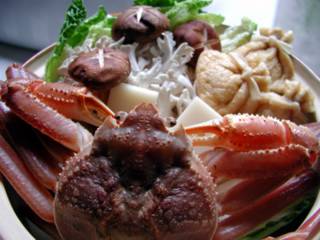Although I love nabe for the obvious reasons, Jason is not a huge fan. I don’t understand what the man has against nabe. After all, this is the same person who asks me to make chicken soup almost every week in the winter. Soup, nabe, what is the difference? So serving nabe for dinner is like planning a sneak attack, and it goes like this:
Jason, “What are we having for dinner tonight?”
Me, “Oh, I don’t know. I’ll think of something when I go to the grocery store.”
Come dinnertime: burner and clay pot all set to go.
Me, “Ta-da! I saw a new kimchi-flavored nabe stock at the supermarket and thought we’d give it a try.”
Jason, “Not nabe agaaaaaaaaaain!”
Mind you, I have put in a lot of thoughts in the nabe I make over the years. Every time I order nabe in a restaurant, I am always careful to take note of any unique ingredients, or the technique employed in making the zousui at the end. Ah, the zousui is another reason I love nabe. It means “everything cooked together” and is like a rice porridge. At the end of a nabe meal, when most of the goodies have been scooped up, the soup is brought to a boil, and then the burner is turned off. Immediately, some cooked rice is added to the soup, and a beaten raw egg is poured in egg-drop-soup-style. The lid is then replaced on the heavy clay pot. The residual heat cooks the egg and makes the rice absorb the soup. Ten minutes later, you lift the lid off to find – zousui! Udon noodles or, my favorite, rice cakes can be used in place of rice. When using rice cakes, they need to be placed inside the nabe a little bit before the heat is turned off so that they can turn all gooey. Mmmmmm, nothing beats piping hot rice cake melting inside your mouth. BUT, not even zousui can sway Jason in favor of the nabe. He finds it too starchy.
That is why it is imperative that the season’s first nabe makes a good impression on Jason so we can have more later. This year, I found the perfect solution: crabs. Who does not love crabs? So for our first nabe of the season, I chose zuwaigani (a long-legged Japanese variety with not-too-hard shells) as the main ingredient, and for stock I used a non-overpowering kelp base as I trust the crab to do enough flavoring on its own. To give it a gourmet touch, I even pre-cracked the legs so someone wouldn’t complain about how hard it is to eat crabs (although I obviously need more practice in this area since some of the legs were almost severed in half, oops).

As predicted, nothing could possibly go wrong when you throw crab in the nabe. Jason even went so far as to say he enjoyed it, but was quick to add, “It doesn’t mean I want to have nabe every week though!” Darn, I was so close!


 Stumble It!
Stumble It!
1 comment:
"Thought he was too lazy to get to past the shell to the meat."
True, hence the soft-shelled zuwaigani and pre-cracking the legs.
But Nabe is not Japan-specific. Don't you eat hotpots in Singapore? I remember having something called "xiao wan mian" at the Bedok hawker center that is essentially a mini nabe of noodles.
Post a Comment